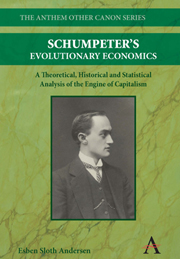 Schumpeter's Evolutionary Economics
Schumpeter's Evolutionary Economics Book contents
- Frontmatter
- Contents
- List of Figures
- List of Tables
- Preface
- Acknowledgements
- Abbreviations
- 1 Introduction
- I Equilibrium Economics and Evolutionary Economics
- 2 The Early Years
- 3 From Walrasian Statics To Evolutionary Dynamics
- 4 Elitist Dichotomies and General Evolutionary Analysis
- 5 Evolutionary Dynamics in the Capitalist Economy
- II The Evolutionary Trilogy
- III Works in Progress
- Appendices
- Schumpeter's Works
- Other References
- Index of Schumpeter's Works
- Index of Persons
3 - From Walrasian Statics To Evolutionary Dynamics
from I - Equilibrium Economics and Evolutionary Economics
Published online by Cambridge University Press: 05 March 2012
- Frontmatter
- Contents
- List of Figures
- List of Tables
- Preface
- Acknowledgements
- Abbreviations
- 1 Introduction
- I Equilibrium Economics and Evolutionary Economics
- 2 The Early Years
- 3 From Walrasian Statics To Evolutionary Dynamics
- 4 Elitist Dichotomies and General Evolutionary Analysis
- 5 Evolutionary Dynamics in the Capitalist Economy
- II The Evolutionary Trilogy
- III Works in Progress
- Appendices
- Schumpeter's Works
- Other References
- Index of Schumpeter's Works
- Index of Persons
Summary
It is presently 100 years since Schumpeter published his first book. This book is largely about the foundations of analytical economics and it was published when he was 25. Therefore, the following formulations by Stanley Fischer (1987, 235–6) may read as if they describe his book:
“Foundations is the work of a 25-year-old. There are signs of youth in the eagerness to proselytize for the new mathematical faith and overreaching in trying to impose an entirely coherent theme on the material. But the book bears the unmistakable command of the economics of his material, at home with technique, and most remarkably for a young man in a hurry, thoroughly familiar and patient with the literature. It is, as Schumpeter no doubt remarked, a remarkable performance.”
Schumpeter's praise, however, was not for himself but for his friend Paul Samuelson. Like Schumpeter, Samuelson finished his PhD thesis at the age of 25. At that age, both of them had ploughed through an enormous literature with an emphasis on the underlying formal structures and analytical tools. They had found widespread confusion and a lack of recognition of the basic unity under the multiform surface of topics and modes of formulation, and they both wanted to overcome confusion and lay the foundations for future research.
- Type
- Chapter
- Information
- Schumpeter's Evolutionary EconomicsA Theoretical, Historical and Statistical Analysis of the Engine of Capitalism, pp. 39 - 66Publisher: Anthem PressPrint publication year: 2009


